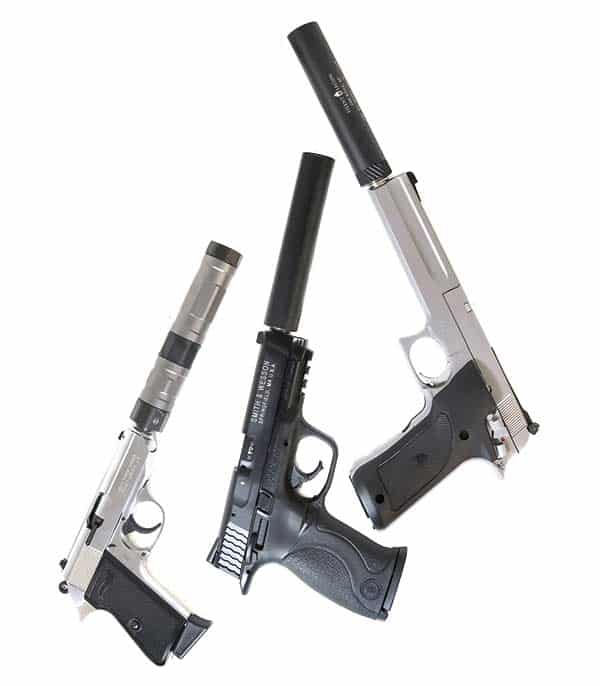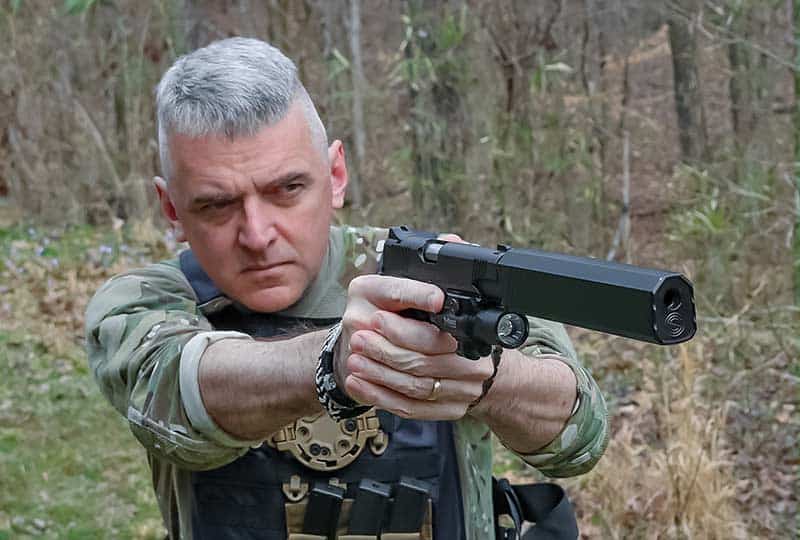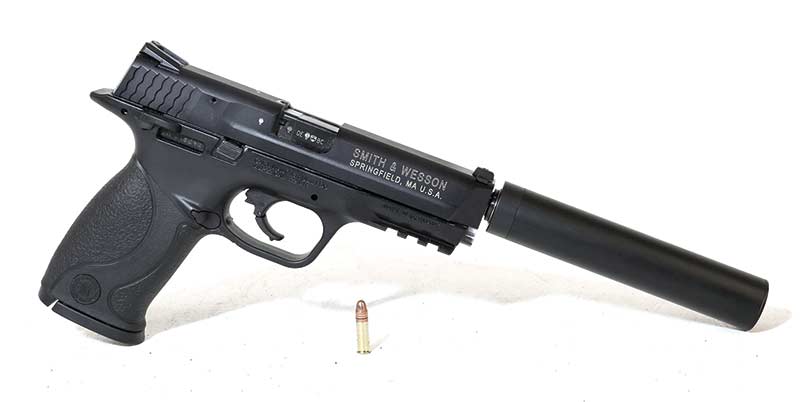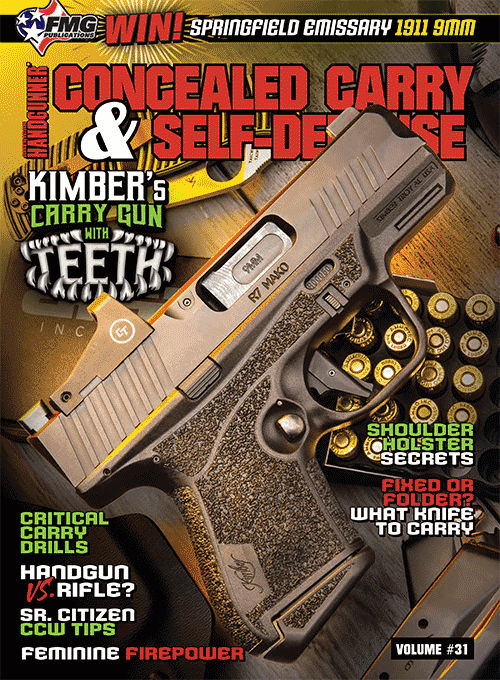119
Suppressors For Home Defense
The Underappreciated Necessity
Geeks like me have spilt an ocean of ink over the salient attributes of the ideal home-defense weapon. The particulars of handguns versus rifles versus shotguns are the stuff that help keep my family warm and fed. Various tactical scenarios along with the guns and gear to best address them have sold literally countless top-quality gun magazines like the one you are currently clutching. However, I would assert this deep into the Information Age, we might just all be doing it wrong.
If you ever have to use a defensive gun for real, it likely won’t be after a good night’s sleep and waffles at the local IHOP. More often than not, it will be in the dead of night when your head is thick, and your heart is beating out of your chest. In addition to the threat, there will also likely be friendlies about. Not just any friendlies, but those whom you hold most precious in the world.
A big part of successfully prosecuting such an engagement is the ability to communicate. You need to be able to direct children to safety, issue commands to the perpetrators and then cogently interact with responding law enforcement officers. If you have just discharged a powerful firearm in an enclosed space, this becomes no mean feat.
A modern sound suppressor does not render a firearm silent by any means. It does, however, excise enough of the auditory chaos to preserve your hearing in the critical moments after the shooting and minimize the disorientation that can result from such a pounding. Additionally, modern sound suppressors typically make guns more controllable and, if anything, incrementally more reliable. So long as you live in one of the free states and you have the means, a sound suppressor really should be an integral component of your primary defensive weapon.

The SilencerCo Switchback suppressor on this Walther PPK/S .22 can be optimized for stealth
or suppression by swapping out components. The Silent Legion Direct Thread Rimfire can on
this S&W 2206 is stupid quiet and allows you an unobstructed view of the sights. The Gemtech
Outback on the S&W M&P .22 has rendered superlative service for decades.
Ballistic Bigotry
When I was a kid, suppressors were illegal under Mississippi law. Most Americans drank the Kool-Aid and convinced themselves silencers were the sole purview of steely eyed professional assassins skulking about taking life for money. Fortunately, some really cool guys lobbied our state legislature to get that specific prohibition stricken from the Mississippi code.
The institutional stigma ran deep. When I bought my first can, the local high sheriff told me in all seriousness if he heard of somebody getting shot in his county with a gun that didn’t make any noise, he was coming for me. We’ve come a long way since then.
Sound suppressors fell prey to the National Firearms Act of 1934. There has seriously never been a more egregious violation of both the spirit and the letter of the U.S. Constitution enacted since the genesis of our Great Republic. Abbreviated as “NFA,” this accursed thing is a case study in unconstitutional government overreach.
Origin Story
Then, as now, politicians never miss an opportunity to weaponize a crisis. In 1934, the country was still clawing its way out of the Great Depression. Americans were both discouraged and broke. Prohibition had run its course from 1920 until 1933 and, in so doing, spawned a simply breathtaking explosion in organized crime. The exploits of the heavily armed motorized bandit captivated the public via newsreels and newspapers. As always, perception became reality.
Gangsters the likes of Capone, Dillinger, Pretty Boy Floyd and Homer van Meter made good newspaper copy, but they were never terribly common in the grand scheme. Back then there were no controls on the sale or possession of guns at all, and any American with money could pick up a fully automatic Thompson or Browning Automatic Rifle through their local hardware store cash and carry. It was simply that nobody but the criminals had any money.
In response, Congress passed the NFA. This was intended to be an omnibus restructuring of the American firearms ethos. Unlike today, legislators actually read the Constitution from time to time and appreciated this foundational document didn’t give them the power to outright ban stuff. As a result, they just levied an astronomical $200 tax on the transfer of the things they didn’t like. As $200 in 1934 is the equivalent of around $4,000 today, this instantly shut down legal commerce of the affected guns. Predictably, the criminals didn’t much care.
The NFA restricted machine guns, destructive devices like cannons and hand grenades, sound suppressors and short-barreled weapons. I have read in its original form the NFA also lumped handguns in for the $200 tax, but this language had to be stricken to gain final passage. Interestingly, the only reason short-barreled rifles and shotguns were supposedly included was because those who drafted the thing realized Americans would cut down their long guns if handguns were banned. The pistol language was removed, but nobody thought to tidy up the short-barreled prohibitions.
This is the reason a gun that will hide in your front jeans pocket is cash and carry, while an AR-15 with a 14.5″ barrel and 30″ overall length requires a $200 tribute and nine-month wait. The current convulsions we are undergoing over pistol stabilizing braces all stem from this administrative oversight. Randy Weaver’s wife and teenaged son were killed by federal agents at Ruby Ridge over the length of a shotgun barrel. Taken in context, the thought leaves me just a little bit ill.
Sound suppressors are themselves quite harmless. I suppose you could beat somebody to death with one, but a proper baseball bat would be a markedly more efficient choice. Back in 1934, gangsters did not use sound suppressors in their nefarious crimes. That’s a myth. Suppressors were included because poor hungry people were poaching game. Wealthy landowners did not want suppressors in circulation, so they could better keep folks from killing their deer. This brings us to today.
Sound Suppressors in Modern Day America
Nowadays, 42 states allow civilian ownership of sound suppressors. The remaining eight are the usual suspects of draconian freedom-averse authoritarian communist-wannabes. Not meaning to name names, but that would include California, Delaware, Hawaii, Illinois, Massachusetts, New York, New Jersey and Rhode Island. To be honest, if I had the misfortune of living some place that sucked that bad, I would just move.
In the early 1900s, Hiram Maxim marketed the first commercial sound suppressors in the back of gun magazines. They sold through the mail for $3.23 apiece. The state of the art has progressed markedly since then.
Today, there are around a million sound suppressors in the NFRTR (National Firearms Registry and Transfer Record). It is these million cans that cause NFA transfers to take upward of a year to process. Despite these simply breathtaking numbers, you are still markedly more likely to be struck by lightning than to be shot with a sound-suppressed weapon in America.
A few short years ago, passage of the Hearing Protection Act seemed like a real possibility. This would have deregulated sound suppressors and had them transfer just like a conventional firearm. Buddies on the inside at BATF were rabid to get the thing passed.
In 2020, the hardworking folks at the BATF NFA branch processed 487,745 NFA registration applications along with another 512,315 related forms. That’s 3,831 forms processed per workday. It’s the reason these things take so long. They also collected $51,700,000 in transfer taxes and another $8 million in dealers’ taxes. It’s the biggest reason the government will never give it up. Uncle Sam really, really, really likes money.
These days, you can even order sound suppressors and manage the associated paperwork from home over the internet. The Silencer Shop has raised this to an art form. Their website will walk you through the process. It is actually quite cool.
Why Does It Matter?
Train like you fight. Though I have thankfully never shot anybody, I have had to access a gun for real a few times. In each case, it was amazing how much of the fine motor activity necessary to bring my weapon into action really did come naturally and without conscious thought. It was only afterward I questioned how exactly I went about doing what I did. Range time spent training is extremely important.
Using a sound suppressor on the firing range makes you a better neighbor. Modern cans are essentially maintenance free and just crazy reliable. They do, however, flavor the shooting experience.
I started with an inexpensive rimfire can on my Walther P22 and literally shot it until the slide broke in half. It took piles of rounds to get there, and Walther had the gun repaired and back in my hands in nine days flat. After that, a proper suppressor for my primary home-defense handgun and another for my favorite black rifle substantially enhance my tactical capabilities when life is about to get truly sideways.
The $200 is hardly front pocket change, but it isn’t the princely sum it once was. Additionally, they tell me patience is a virtue, so those of us who have endured the BATF Form 4 process a few times should indeed be remarkably virtuous. As a result, there really isn’t much excuse for the American shooter of reasonable means who lives in the appropriately free locale not to avail himself or herself of a proper sound suppressor. You’ll never go back to noisy guns again.
For more info: SilencerShop.com

Sign up for the Personal Defense newsletter here:










